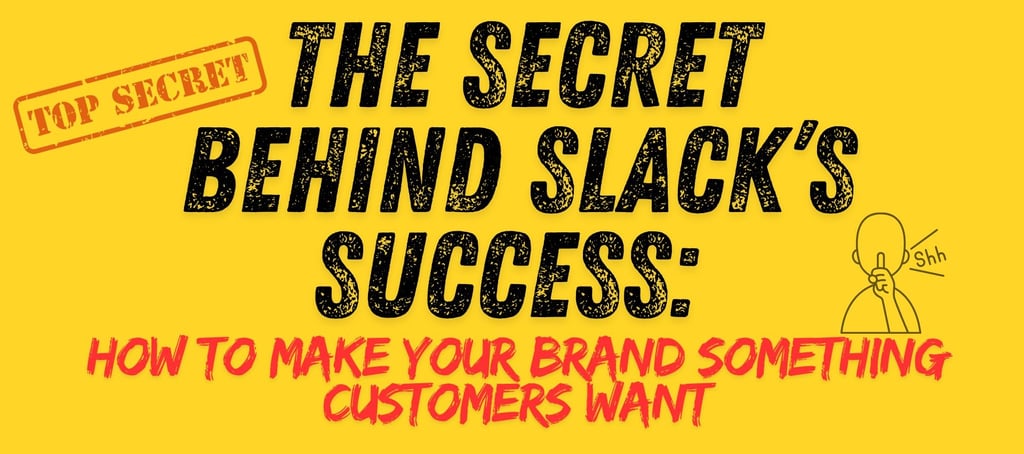The Secret Behind Slack’s Success: How to Make Your Brand Something Customers Want


Ever wonder why some brands explode in popularity while others fade into obscurity?
The answer lies in positioning - and no company proves this better than Slack.
Slack didn’t start as a workplace productivity tool.
It was born from a failed gaming startup.
But through smart repositioning, it transformed into a $27.7 billion acquisition by Salesforce.
The secret?
They stopped selling “saddles” and started selling “horseback riding.” 🏇
Let’s break down how Slack cracked the code to positioning their brand as a must-have and how you can do the same.
🔄 The Pivot That Saved Slack
Back in 2012, Stewart Butterfield was running a gaming startup called Glitch.
While building the game, they created an internal communication tool.
Not just any chat app – a gamified, engaging platform that their team absolutely loved.
It was fun, easy to use, and quickly became an essential part of their workflow.
As the gaming dream faded, Butterfield made a bold decision that would reshape the future of work.
Ditched the game but kept the chat tool!
He rebranded it as Slack and launched it in 2013.
💡 Lesson #1: Sometimes, your best idea isn’t what you originally set out to build.
📢 The Early Traction - and the Big Problem
Thanks to Butterfield’s reputation with Flickr, Slack got early users fast.
People loved it.
But there was a huge problem:
Decision-makers weren’t willing to pay.
Slack was just another “group chat app.” CTOs and directors didn’t see a compelling reason to upgrade to a paid plan.
💡 Lesson #2: If your target customers don’t see the value, your product won’t scale- no matter how good it is.
📝 Repositioning: From “Group Chat” to “The Future of Work”
Butterfield dug deep into customer feedback. What he found was game-changing:
💡 Customers who used Slack held fewer meetings and sent fewer emails.
💡 Teams were more organized and less stressed.
💡 Slack wasn’t just a chat tool—it was a new way of working.
So, instead of selling group chat, Slack repositioned itself as the solution to workplace inefficiency and stress.
Butterfield made this clear in his now-famous Medium post: “We don’t sell saddles here.”
💡 Lesson #3: People don’t buy products. They buy better versions of themselves.
🎯 How to Make YOUR Brand Something Customers Want
Slack’s success wasn’t luck. They cracked the code of customer-driven positioning by answering six key questions:
1️⃣ Buying Triggers – What moment makes your customer realize they have a problem?
Slack’s triggers: Missed emails, tool overload, articles on collaboration costs.
🎯 Your move: Tie your brand to these “aha moments” (e.g., Rolex = success milestones).
2️⃣ Problem Clarity – What’s the REAL problem you solve?
Slack repositioned from “fun group chat” to “workplace efficiency booster.”
Slack’s surface problem: “Chat apps are boring.”
Deeper problem: “Teamwork is broken.”
🎯 Ask: “Does our solution tackle a hair-on-fire issue?”
3️⃣ Context Matters – When do customers need your product the most?
A milkshake isn’t just a drink - it’s a commute snack or kid’s treat.
Slack’s context: Remote teams juggling 10+ tools.
🎯 Pro tip: Map how customers use your product in the wild.
4️⃣ Specific Actions – What steps do customers take to solve the problem?
Slack’s fix: Channels, integrations, archives.
🎯 Ask: “What steps do customers take to solve their problem? Become those steps.”
5️⃣ Crush Objections – What mental barriers stop them from adopting your product?
Slack’s hurdles: “Too pricey,” “Just another app.”
🎯 Fix it: Bake answers into your messaging (e.g., “Cut 8 hours/week” > “It’s expensive”).
6️⃣ Desired Outcome – What transformation do they seek?
Beyond function: Slack users wanted less stress, team pride, and modern vibes.
🎯 Goldmine: Sell the emotion (confidence, relief) and social wins (being seen as innovative).
💡 Lesson #4: The value of your brand is not in what it does, but in how it changes customers’ lives.
🌟 Final Takeaway: Positioning Creates Perceived Value
Success isn't just about building a great product – it's about understanding what your customers truly want to achieve.
Slack’s meteoric rise was all about framing. The same product - branded differently - became indispensable.
Slack’s magic wasn’t the product - it was the story. By reframing from “chat tool” to “work revolution,” they tapped into deeper desires: efficiency, calm, and belonging.
If you want your brand to be something customers want, need, and can’t live without, ask yourself:
✅ Are we positioning our brand based on what customers truly desire?
✅ Are we solving an urgent, valuable, and recognized problem?
✅ Are we communicating our value in a way that resonates?
Remember:
Branding isn’t about what you sell - it’s about what people believe they’re getting.
🔔 Follow for More: Don't miss out on future articles packed with practical tips and inspiring ideas.
Visit my website Kamaleonte Marketing.
Subscribe to my newsletter AI Sapiens.
Stay informed, stay adaptable, and keep thriving
